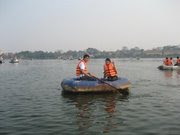The Japanese alphabet consists of 99 sounds formed with 5 vowels (a, e, i, o, and u) and 14 consonants (k, s, t, h, m, y, r, w, g, z, d, b, p, and n), as is shown in the hiragana chart.
Long vowels
"" is sometimes used to create long vowels. In
, for instance, the last letter is not pronounced "u" but as a long "o."
Double consonants
In , there's a pause between "
" and "
." The little "
" has a function of creating a pause, so
has six syllables.
Particles
When "" and "
" are used as a particle (particles will be explained later), they are pronounced as "wa" and "e":
and
.

No comments:
Post a Comment